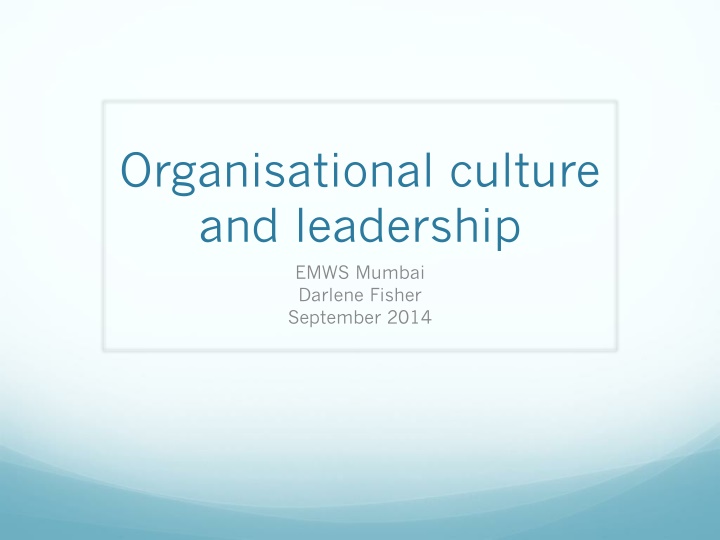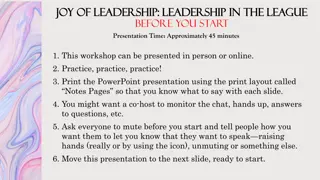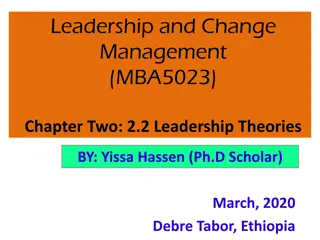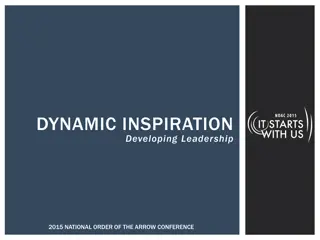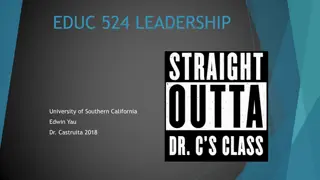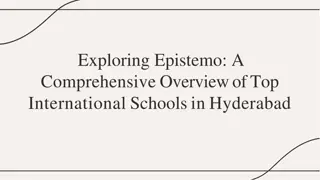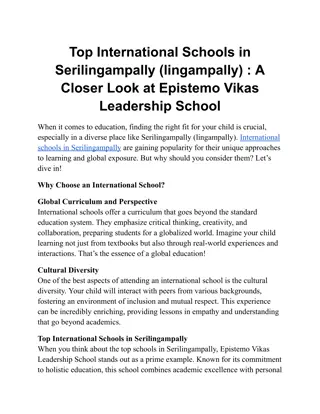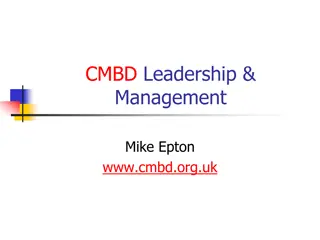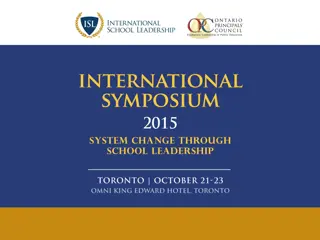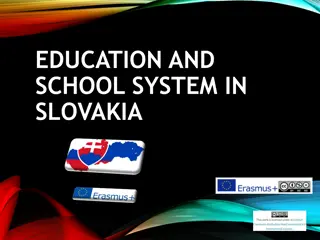Effective Leadership in International Schools
Delve into the diverse leadership styles and cultural influences that shape effective leadership in international schools. Understand the nuances between Western and Eastern leadership approaches, and the challenges faced in managing international curriculum schools.
Download Presentation

Please find below an Image/Link to download the presentation.
The content on the website is provided AS IS for your information and personal use only. It may not be sold, licensed, or shared on other websites without obtaining consent from the author.If you encounter any issues during the download, it is possible that the publisher has removed the file from their server.
You are allowed to download the files provided on this website for personal or commercial use, subject to the condition that they are used lawfully. All files are the property of their respective owners.
The content on the website is provided AS IS for your information and personal use only. It may not be sold, licensed, or shared on other websites without obtaining consent from the author.
E N D
Presentation Transcript
Organisational culture and leadership EMWS Mumbai Darlene Fisher September 2014
Outline 1. What is leadership 2. Culture and leadership 3. Organisational culture and leadership 4. Where to from here?
Effective leadership What 7 10 characteristics do you associate with effective leadership?
What characteristics do you believe are required for effective school leadership in an international school?
Cultures, geography and leadership
Hofstedes cultural dimensions Power distance PDI Individualism/ Collectivism IDV Masculinity / Femininity MAS Uncertainty avoidance UAI Long term orientation LTO
Geography of leadership What does this image present as a difference in leadership styles in different cultures?
How do expectations of good leadership differ between cultures?
Questions 1. What leadership styles do we associate with western schools in general? 2. What leadership styles do we associate with eastern schools in general? 3. What leadership styles do we expect in international curriculum schools? 4. What issues might arise out of the differences between your answers to Q1-3?
Challenges in international schools?
Universal leadership attributes? Is there such a thing?
Day et al 10 strong claims Headteachers are the main source of leadership in their schools. There are eight key dimensions of successful leadership.* Head teachers values are key components in their success. Successful heads use the same basic leadership practices, but there is no single model for achieving success. Differences in context affect the nature, direction and pace of leadership actions.
Day et al cont Heads contribute to student learning and achievement through a combination and accumulation of strategies and actions There are three broad phases of leadership success staffing, focus on curriculum & curriculum change. Heads grow and secure success by layering leadership strategies and actions. Successful heads distribute leadership progressively The successful distribution of leadership depends on the establishment of trust.
GLOBE universals GLOBE decided on 9 Dimensions across different cultural clusters
GLOBEs 9 Dimensions Power distance Uncertainty avoidance Humane Orientation Collectivism (institutional) Collectivism (in group) Assertiveness Gender Egalitarianism Future Orientation Performance Orientation
What did they study? an outstanding leader is a person in an organization or industry who is "exceptionally skilled at motivating, influencing, or enabling you, others, or groups to contribute to the success of the organization or task. 112 traits were studied with reference to how they might enable or hinder a leader from being this person
21 leadership scales Integrity (6.07) Inspirational (6.07) Visionary (6.02) Performance-oriented (6.02) Team-integrator (5.88) Decisive (5.80) Administratively competent (5.76) Diplomatic (5.49) Collaborative team orientation (5.46) Self-sacrificial (5.0)
21 characteristics cont Modesty (4.98) Humane (4.78) Status conscious (4.34) Conflict inducer (3.97) Procedural (3.87) Autonomous (3.85) Face saver (2.92) Non-participative (2.66) Autocratic (2.65) Self-centered (2.17) Malevolent (1.80).
6 leadership styles 1. The charismatic/value based style (4.5 6.5) 2. The team-oriented style (4.7 6.2) 3. The participative style (4.5 6.1) 4. The humane style (3.8 5.6) 5. The self-protective (2.5 4.6) 6. The autonomous style (2.3 4.7)
Culturally contingent leadership characteristics A more detailed analysis identified that leader characteristics such as [being] ambitious, enthusiastic, formal, logical, or risk taker are valued very differently around the world. For example, on GLOBE's 7-point scale to measure a society's view of these leader traits, the culture means for risk taker range from 2 to 6. This is in line with the extent to which countries tolerate uncertainty
Leadership? Q What might be recommended and what might depend on the context ?
Organisational culture http://www.managementparadise.com/article_print.php?article_id=1061
How does the leader lead the culture with his/her behaviours? How does SLT lead the culture with their behaviour? What are the org. practices which exemplify the culture? How does the behaviour of teachers, students and all in the community exemplify the culture? What are the assumptions values and beliefs that need to be shared by the community? What actions show the way we do things here on a daily basis? How do we make sure our culture reflects our mission and vision and is visible and clear to all who visit?
Communication -through Culture -through Culture http://phprimer.afmc.ca/Part3-PracticeImprovingHealth/Chapter10IdentifyingHazardsAndCommunicatingRisks/RiskCommunication
Bibliography Aslan, M., Beycioglu, K., & Konan, N., (2008) Principals Openness to Change in Malatya, Turkey. International Electronic Journal For Leadership in Learning. 12, Number 8 Chen, C., Chen, X., & Meindl, J., (1998) How can Cooperation be Fostered? The cultural effects of individuals and Collectivism. Academy of Management Review. Vol. 23, No. 2, 285-304. Cheng, Kai-ming(1998) Can education values be borrowed? Looking into cultural differences', Peabody Journal of Education, 73: 2, 11 30 Hofstede, G., Cultural Dimensions accessed June to December 2009 from http://www.geert- hofstede.com Hofstede, G., and Hofstede, G.J., (2005), Cultures and Organizations - Software of the Mind. London: Mc Graw Hill, UK. James, C & Connolly, M., (2009) An analysis of the relationship between the organizational culture and the performance of staff work groups in schools and the development of an explanatory model. International Journal of Leadership in Education, 12: 4, 389 407. Joy, S., & Kolb, D.A., (2009), Are there cultural differences in learning style? International Journal of Intercultural Relations , 33, 69 85.
Leithwood, K., (1994) Leadership for School Restructuring. Educational Administration Quarterly 30; 498. Leithwood, K., & Duke, D. L. (1998) Mapping the conceptual terrain of leadership: A critical point of departure for cross-cultural studies, Peabody Journal of Education, 73: 2, 31- 50 LorwatanapongsaP., (2003) Cross-cultural communication in international schools. (Unpublished Doctoral dissertation) Katholieke Universiteit Leuven (Belgium);. Publication Number: AAT C818941 Nemetz, P., & Christensen, S., (1996),The Challenge of Cultural Diversity; A Harnessing a Diversity of Views to Understand Multiculturalism. Academy of Management Review21, No. 2. 434-462 Portin, Bradley S.(2009) 'Cross-national professional learning for school leaders', International Journal of Leadership in Education, 12: 3, 239 252 Schlichting-Artur, S., (2009), Learning to Listen: Pursuing Leadership Strategies for Achieving Multiculturalism in Educational Administrative Work Environments. (Unpublished Dissertation for Doctorate) University of Pennsylvania. Weigl, R., (2009) Intercultural competence through cultural self-study: A strategy for adult learners. International Journal of Intercultural Relations 33, 346 360 Xie, Rau, Tseng, Su and Zhao (2009) Cross-cultural influence on communication effectiveness and user interface design. International Journal of Intercultural Relations. 33. 11 20.
